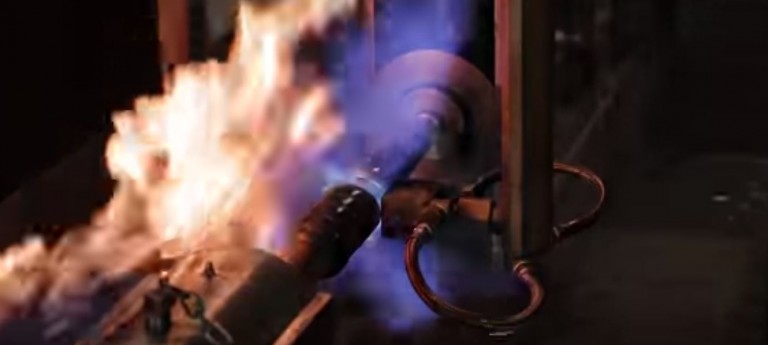Coming Up for Air

In our last blog post, we talked about the art of choosing and using the proper fuel gas for your application. Flame hardening allows for different types of fuel gas to be used, depending on the amount and speed of heat you need.
But ALL flame hardeners use oxygen. It’s the oxygen that causes the flame to release enough heat to increase your rate of combustion. You can get fire just using the air of the atmosphere with your fuel gas, but you won’t get enough heat that way to flame harden your metal. The rate of combustion achieved with oxygen and fuel gas creates the high heat you need to successfully flame harden steel and cast iron.
That’s why oxygen delivery is a critical component of our flame hardener designs. It’s equally important to the fuel gas delivery, and the design must take into account the type of fuel gas chosen for an application.
Dow Chemical labs did studies back in the 1960s that yielded the ideal quantity of combined fuel and oxygen to be delivered to a particular flame port. Until then these quantities had never been measured accurately. The flame hardening process was less measured and more by sight and experience. The lab tests then took the quantities measured at the port and broke them down further, obtaining measurements for the optimal flame port size, whether it should be counter bored or not, and what an optimum delivery of fuel and oxygen would be.
The results of Dow’s tests are still followed today. The ideal proportion of how much fuel and how much oxygen goes through the flame port typically follow these parameters:
Natural gas – 2 parts oxygen to 1 gas
Propane gas – 3.5 oxygen to 1 part gas
These results show that oxygen amounts can be two to almost four times the amount of gas going through a flame head. Your delivery system must be able to deliver not only the quantity of oxygen required to produce the flame, but also at the rate required.
The two standard delivery systems we see are: 1) cylinders of compressed oxygen gas; or 2) cylinders of liquid oxygen that is converted to gas as it leaves the cylinder. Depending on the application, you will most likely use a bank of oxygen gas cylinders in order to get the needed volume.
Liquid oxygen tends to cost less, but liquid tanks lose oxygen when not in use. Because you need to get so much oxygen so fast, and liquid must convert to gas fast enough to meet the rate requirements, you might need a larger size of container on your site than your budget allows. Determining whether to use gas cylinders or liquid tanks of oxygen is a cost and flow question best answered in concert with one of our design engineers.
When it comes to using oxygen and fuel gas to produce combustion, any careful engineer will have questions about safety. At Flame Treating Systems we are so concerned about safety, none of our flame hardeners have ever had any combustion accidents in over 40 years of manufacturing. The biggest risk of unintended combustion comes in the piping for the oxygen delivery system. No combustible material can be inside a pipe delivering oxygen. Every delivery pipe needs to be acetoned or cleaned in some way. Most of our customers used cleaned copper pipe to deliver oxygen to the flame hardener. The pipes should be professionally installed by someone who oxygen-cleans the piping system. Any combustible material left in the pipes could ignite an explosion when the oxygen comes in contact with it. As long as these pipes are maintained, you will avoid combustion hazards.
I hope this blog continues to help you refine your flame hardening processes and leads you to the results you need. Email me at mark@flametreatingsystems.com
B27: We would like to know your opinion.






